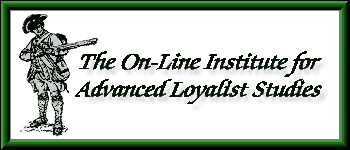

|
 |
|
The history of the King's American Regiment is presented in 8 parts. Click below to skip to:
Part 1 - Introduction & Recruiting a Regiment |
A History of the King's American Regiment - Part 2 of 8 |
|
From Recruits to Soldiers Raising a regiment in the 18th Century was much different than joining the Army of today. A recruit joining a corps being raised by the British in war torn America could expect immediate service, with little or no formal training period. Recruits were expected to learn to be soldiers while they actually served in the field. We have discussed previously how many of the recruits actually had to fight to simply join the army in the first place. When the King's American Regiment was raised initially in December of 1776, there was no name to the unit. It was known simply as Fanning's Corps. It was not until 6 April 1777 that they were given a name: His Excellency Sir Willm. HOWE Kt. Bath Commander in Chief of His Majesty's Forces &c &c having been pleased to approve of the Regiment now raising under Command of Coll. FANNING being called and distinguished from the other American Corps by the Name of The Kings American Regiment all Muster Rolls, Inspection Rolls, Reports &c &c Companies Regimental Returns &c are in future to be made out under that Application, or Title.22 A major problem when the corps was recruiting was the lack of uniform clothing. Provincial uniforms were only sent from England late in 1776, and they did not arrive in New York until April of 1777. Before any uniforms arrived, the clothing worn by the KAR probably made them appear almost indistinguishable from a Rebel corps. Indeed, all the Inspector General of Provincial Forces could offer the regiment in February of 1777 were shoes and stockings. Prior to the regiment's inspection, he desired the troops to have "their Cloaths…clean, Shirts Wash'd and button'd, Collar and Wristband, their Hats brush'd and turn'd up, fastned up on one side, their Hair Cut short & all Remnants or badges of the Rebel Service on the Cloaths of any of them Carefully taken off and conceal'd."23 Jacob MIDDAUGH, one of the men apparently in Captain FUGE's Company and in Jacobus ROSE's party, mentioned that he was offered "a Shirt and Trowsers but would not take them, choosing to have all his Cloaths together…"24 MIDDAUGH explained to the other recruits that "each man should have two Pair of Stockings a Pair of Shoes a Pair of Breeches and two Shirts a red Coat or Red Jacket…and a Waistcoat…"25 Both red coats and green coats were sent over for the Provincial Forces. It is not entirely certain which the regiment got, and it is not clear how MIDDAUGH came by his information, as the uniforms had not yet arrived to be issued. One suspect original account, however, lists their uniform color as red.26 To defray the cost of clothing to the soldier, each was given a bounty of two guineas (forty two shillings). In addition, extra clothing purchased in America (known as necessaries) was purchased for them by the captains commanding companies. The inhabitants of New York, organized by one Thomas WHITE, took up a subscription to raise money to buy extra clothing quickly for those corps from New York. The KAR received as their part of this donation 350 shirts, 452 pair of shoes and 516 blankets or blanket coats.27 As an inducement to new recruits, enlistees were promised a future after the war— fifty acres of land to each soldier and two hundred acres to each non commissioned officer. These grants were modeled after the King's Proclamation of 1763, which awarded land to veterans of the French and Indian War.28 To assist in the training of many of the new regiments, the British placed regular sergeants or junior officers in staff positions. For the KAR, they were given William WATKINS of the British Marines, who was appointed adjutant on 26 July 1777.29 The adjutant would assign the officers their duty and help instruct the soldiers in their drill and maneuvers. The officers and men were posted and divided into ten companies, in the manner of British regiments. As with regular regiments of the time, there were eight battalion companies, one of grenadiers and one of light infantry. Abraham DePEYSTER was posted to the grenadiers while Thomas CORNWELL was given the command of the light infantry. Both were Long Island Loyalists. After FANNING, there were two other field grade officers— Lt. Col. George CAMPBELL, formerly of the Foot Guards, and Major James GRANT, a seconded officer when he joined FANNING in December of 1776. All that was left for the men to do to become real soldiers was to be "qualified." Being qualified meant that the soldier had the Articles of War concerning mutiny and desertion read to him by a justice of the peace or other similar competent civilian authority. This meant they were then liable to military discipline, trial and punishment. This duty was performed by Judge HICKS to the Provincial regiments gathered at Kingsbridge on 24 July 1777. At eight o'clock that morning, the KAR were formed under arms and marched to the field where Major General William TRYON, then commanding all Provincial Forces in New York, and Judge HICKS were awaiting them. The aforementioned articles were read to them, and simple as that, the men became soldiers.30
21 Certificate of Edmund Fanning, 15 May 1780. Headquarters Papers of the British Army in America (Carleton Papers), PRO 30/55/2743, PRO.
Click here for ---> Regimental History Main Page More King's American Regiment History KAR History:
The On-Line Institute for Advanced Loyalist Studies
|